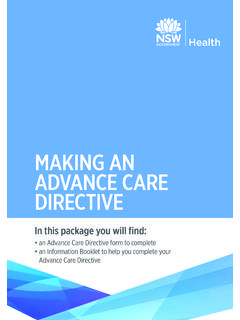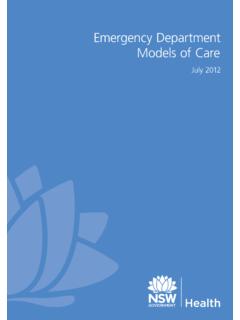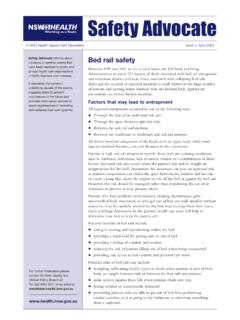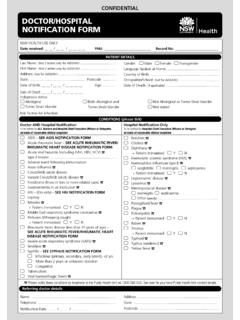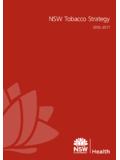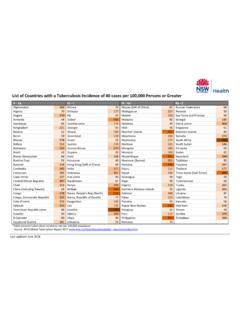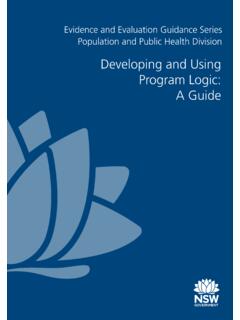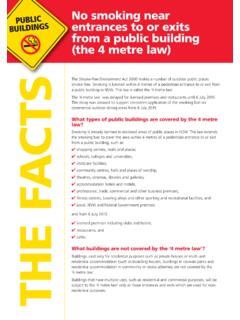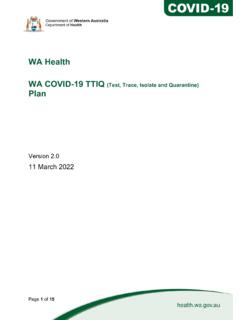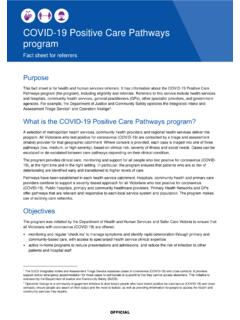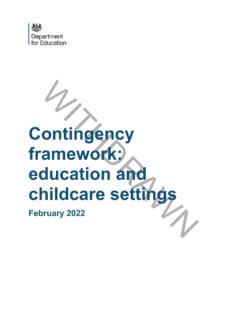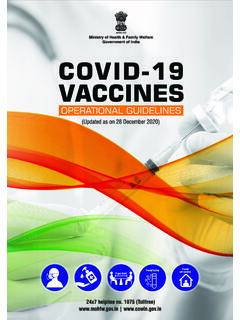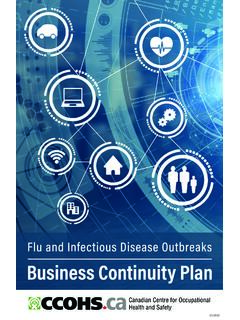Transcription of GASTRO PACK FOR HOSPITALS AND AGED CARE FACILITIES
1 Information pack for Gastroenteritis in a hospital November 2018 GASTRO pack FOR HOSPITALS AND aged care FACILITIES What is the purpose of this information pack ? This package has been produced to assist HOSPITALS and aged care FACILITIES in the event of a suspected or confirmed outbreak of gastroenteritis and provides information on its early identification, prevention and control. Who needs to read it and be familiar with it? All health care workers of your hospital , but in particular infection control professionals, nurse unit managers and aged care facility managers, should have access to and read the information provided in this pack . This will help to ensure early identification and response to gastroenteritis outbreaks and can mean fewer people (patients and staff) with gastroenteritis in your hospital or aged care facility.
2 When will you need to use it? The pack will be of use in the event of a gastroenteritis outbreak in your hospital or aged care facility. NSW Health defines a suspected outbreak as two or more people with sudden onset of vomiting or diarrhoea at the one time in any institution. At one time means that at least one person within an institution develops vomiting or diarrhoea within an incubation period of when at least one other person at the institution was infectious with vomiting or diarrhoea. This includes situations where patients are received from another facility/agent. How can I plan for an outbreak of gastroenteritis? HOSPITALS and aged care FACILITIES should have a documented outbreak plan that includes: recognising an outbreak , what is your response, infection prevention and control, escalation, cleaning, education and communication.
3 Who should I contact? Gastroenteritis in an institution among people of any age and food borne illness suspected in two or more related cases should be notified to your local public health unit (NSW Department of Health. Notification of Diseases under the Public Health Act 2010, Information Bulletin IB2013_010, available at: Notifying NSW Health of such an outbreak is obligatory for Chief Executive Officers (or their delegates) of HOSPITALS and nursing homes and medical practitioners, and is recommended for hostels. A list of NSW public health units is provided over the page. How can the public health unit (PHU) help, and what is their role? Your local PHU can assist by providing advice and support in the management and control of an outbreak of gastroenteritis in a hospital or aged care facility.)
4 PHU staff can also provide advice on the most likely cause of the outbreak . PHU staff have expertise in managing infectious disease outbreaks. What is in this pack ? Section 1. Recognising and managing an outbreak of gastroenteritis on your ward Section 2. Viral Gastroenteritis: Infection Control Implications for HOSPITALS and aged care Section 3. Collection of specimens in a gastroenteritis outbreak Section 4. Signage: Staff and visitors posters Section 5. Line listing for cases Section 6. Viral gastroenteritis fact sheet Information pack for Gastroenteritis in a hospital November 2018 Public Health Unit Contacts In NSW calling 1300 066 055 will direct you to your local public health unit. NSW Local Health District Public Health Units Contact Phone Number Central Coast Gosford Office 02 4320 9730 Hunter New England Newcastle Office Tamworth Office 02 4924 6477 02 6764 8000 Illawarra Shoalhaven Wollongong Office 02 4221 6700 Mid North Coast / Northern NSW Port Macquarie Office Lismore Office 02 6588 2750 02 6620 7585 Murrumbidgee / Southern NSW Goulburn Office Albury Office 02 4824 1837 02 6080 8900 Nepean Blue Mountains Penrith Office 02 4734 2022 Northern Sydney Hornsby Office 02 9477 9400 Sydney Camperdown Office 02 9515 9420 South Western Sydney Liverpool Office 02 8778 0855 South Eastern Sydney Randwick Office 02 9382 8333 Western NSW Broken Hill Office Dubbo Office Bathurst Office 08 8080 1499 02 6809 8979 02 6330 5880 Western Sydney Parramatta Office 02 9840 3603
5 Information pack for Gastroenteritis in a hospital November 2018 Two or more people with diarrhoea and/or vomiting in your facility at one time Inform the infection control practitioner & the facility management Refer to section 3: Specimen Collection Information sheet Refer to section 5: Line listing for cases PHU name: Phone number: Refer to section 2: Infection Control Implications for HOSPITALS Inform the medical team, collect faecal specimens and send to laboratory for testing Post signage and alcohol-based hand rubs at entrance to affected ward or facility Refer to section 4: Attention visitors and staff signs Contact your local public health unit & inform them of outbreak Distribute health information to staff, patients and visitors Refer to section 2: Infection Control Implications for HOSPITALS Refer to section 6: Fact sheet: Viral Gastroenteritis NSW HEALTH hospital GASTRO pack SECTION 1 RECOGNISING AND MANAGING AN outbreak OF GASTROENTERITIS ON YOUR WARD GASTRO pack Resources Refer to section 6: Fact sheet: Viral gastroenteritis Institute infection control measures and cleaning Infection Control Officer: Phone number: Steps to be taken within 24 hours of recognition of the outbreak Information pack for Gastroenteritis in a hospital November 2018 NSW HEALTH hospital GASTRO pack SECTION 2 In the event of a gastroenteritis outbreak there are a number of precautions that will prevent the spread of infection and control the outbreak .
6 planning AND management Form an outbreak team to enable decisions, communication and development of strategies to manage the outbreak . HAND HYGIENE Hand hygiene is the most effective way of controlling gastroenteritis pathogens. Hand hygiene must be performed before and after all patient contact. Hand hygiene should occur following contact with the affected patient s immediate environment and following all specimen contact, regardless of whether hands are visibly soiled. If visibly soiled hand washing with soap and water is recommended. Hands should always be washed after personal toileting, before preparing or eating food, and after removing gloves or other personal protective equipment (PPE). Hands should be washed vigorously with liquid soap and water for a minimum of 15 seconds rubbing all surfaces of the hands and wrists.
7 Nails should be kept short. False fingernails, nail extenders, nail polish and jewellery can restrict adequate cleaning of hands and harbour microorganisms including the virus and are therefore not recommended. Refer to the NSW health website for information on hand hygiene and to the NSW Infection Prevention and Control Practice Handbook Patients must be educated on the importance of hand hygiene and given access to hand hygiene FACILITIES . NSW Health Factsheet Most outbreaks of gastroenteritis in institutions are caused by norovirus, and the following control guidelines apply to viral GASTRO outbreaks (including norovirus, rotavirus and sapovirus). However, it is also important to consider toxigenic pathogens (C. perfringens and C. difficile), and bacterial pathogens (Salmonella and Campylobacter), as possible causes of gastroenteritis outbreaks in HOSPITALS and aged care FACILITIES .
8 VIRAL GASTROENTERITIS: INFECTION CONTROL IMPLICATIONS FOR HOSPITALS AND aged care FACILITIES Last updated: 19 Nov 2018 Information pack for Gastroenteritis in a hospital November 2018 STANDARD AND ADDITIONAL (TRANSMISSION-BASED) PRECAUTIONS Standard precautions should be used for ALL patients. Additional precautions (outlined below) should be used for any patient suspected or confirmed to be infected. CONTACT AND DROPLET PRECAUTIONS Contact precautions includes wearing gloves and a plastic apron or impervious gown when having contact with the patient or the patient s environment, especially when attending to patient toileting and hygiene. Protective eyewear and mask must be worn when there is the potential of vomit or faecal splashing. A mask should also be worn when there is the potential for aerosol dissemination.
9 This may occur when attending a vomiting patient, toileting an affected patient, changing and handling soiled linen or any faecal soiled waste, attending a patient s personal hygiene care , disposing of faeces, or cleaning an affected patient s room or environment. If the toilet has a lid, the lid of the toilet should be closed before flushing to stop faecal aerosols being generated. PPE should be removed before leaving the affected patient s room. Hands should be washed after removing PPE in the room and after leaving the room, following the sequence for removing from the Infection Prevention and Control Practice Handbook PERSONAL PROTECTIVE EQUIPMENT (PPE) It is important that staff are competent in the correct wearing and removal of PPE to avoid inadvertently contaminating themselves. PPE should be donned before entering the affected isolation area.
10 Note that cloth gowns should not be worn as they are not impervious or fluid resistant. PPE must be removed in a way that does not allow transmission of gastroenteritis virus to the wearer. Gloves are likely to be heavily contaminated and should be removed first. The steps in removing personal protective equipment are: 1. Remove gloves by rolling back from the wrist. Do not touch skin. 2. Wash hands. 3. Remove mask by touching the tapes only, avoiding contact with the front of the mask, and discard in the waste bin. 4. Remove goggles/visor/shield. 5. Remove gown and fold carefully with contaminated side in and place in the waste bin. 6. Immediately decontaminate hands well using an antimicrobial skin cleanser and water. If not immediately available, use an alcohol hand gel or rub, and wash hands as soon as possible.
